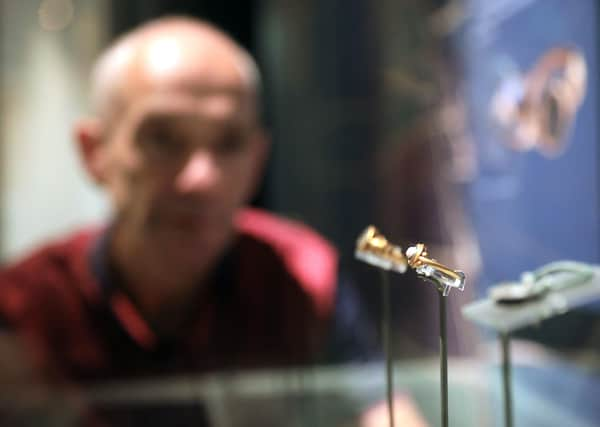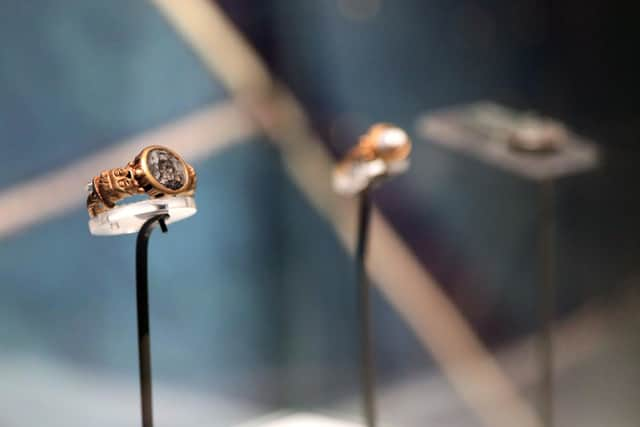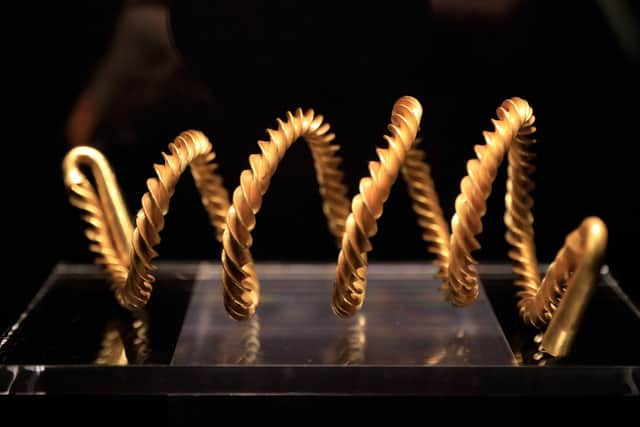Buried treasures unearthed by the public fill gaps at Northern Ireland museums


Some 24 items have been found to be treasure over the last 10 years, according to a Freedom of Information Act response.
Under the Treasure Act, objects are to be reported to the Coroner’s Service before an inquest is held to determine whether or not they are treasure.
Advertisement
Hide AdAdvertisement
Hide AdThe PA news agency can reveal that all 24 items were acquired by National Museums Northern Ireland (NMNI).


A number of these are currently on display at the Ulster Museum in Belfast.
NMNI curator of archaeology Dr Greer Ramsey said they had “significantly filled gaps in our collection”.
He said what they receive is “luck of the draw” as people find items, but he described it as a “major and significant part of our work”.
Advertisement
Hide AdAdvertisement
Hide Ad“There is no doubt they have added significantly to our collections,” he said.


Dr Ramsey highlighted two pieces of gold jewellery dating to the Bronze Age found close to Downpatrick, Co Down and Enniskillen, Co Fermanagh, a Roman hoard found at Murlough in Co Down and a Viking silver arm ring found close to Ballinderry in Co Antrim as being of particular importance.
Dr Ramsey explained that it is rare to find Bronze Age gold objects, particularly such “superb examples of craft”.
One is a 3cm delicately decorated “bulla” likely to have been worn around the neck as a locket, while the other is a torc which would likely have been worn around the neck or waist.
Advertisement
Hide AdAdvertisement
Hide AdDr Ramsey said the torc is the only example of its type in Ireland that has been coiled like a spring, adding that at that time the island was considered the prehistoric El Dorado of Western Europe because of the quality and quality of its gold work.
“They filled really significant gaps in our collection and knowledge of Bronze Age gold jewellery working because they are two superb examples of the craft,” he said.
Dr Ramsey said the Murlough hoard, which has recently gone on display at the Ulster Museum, is significant because Roman material is very rare in Ireland.
Unlike Great Britain, the Romans did not come to Ireland.
Two of the items are gold finger rings while the third is part of a silver military buckle. All date to the late fourth or the earlier part of the fifth century AD.
Advertisement
Hide AdAdvertisement
Hide AdAs to how they ended up on the Irish coastline, Dr Ramsey said they can only speculate that they could have belonged to a British migrant, trader or a returning Irish man who had been living in Roman lands or served in their army.
Alternatively it is possible they belonged to someone returning home who was washed up or buried near the shore.
Meanwhile, one of the latest finds to come to the museum is a silver Viking arm-ring which was found by Michael Thompson in Ballinderry, Co Antrim in 2018.
Dr Ramsey said Viking items are unusual in Northern Ireland compared to the Republic where there were settlements in Dublin and Waterford.
Advertisement
Hide AdAdvertisement
Hide AdHe said it could be brought to the Ulster Museum for display.
“The largest Viking burial outside Scandinavia is in Dublin but when you get into the northern part of Ireland, Viking objects are much rarer so when they turn up, it’s really significant,” he said.
——— ———
A message from the Editor:
Thank you for reading this story on our website. While I have your attention, I also have an important request to make of you.
With the coronavirus lockdown having a major impact on many of our advertisers — and consequently the revenue we receive — we are more reliant than ever on you taking out a digital subscription.
Advertisement
Hide AdAdvertisement
Hide AdSubscribe to newsletter.co.uk and enjoy unlimited access to the best Northern Ireland and UK news and information online and on our app. With a digital subscription, you can read more than 5 articles, see fewer ads, enjoy faster load times, and get access to exclusive newsletters and content. Visit https://www.newsletter.co.uk/subscriptions now to sign up.
Our journalism costs money and we rely on advertising, print and digital revenues to help to support them. By supporting us, we are able to support you in providing trusted, fact-checked content for this website.
Ben Lowry
Acting Editor